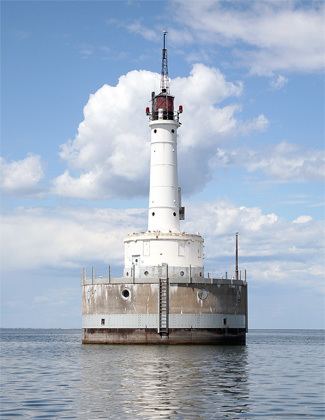Foundation Concrete pier Characteristic occ. red 4s Range 22,224 m Automated 1979 | Construction Steel plate Opened 1935 Focal height 22 m Year first constructed 1935 | |
 | ||
Tower shape white conical tower on cylindrical base Similar Peshtigo Reef Light, Kevich Light, Grassy Island Range Li, Two Rivers Light, Plum Island Range Li | ||
The Green Bay Harbor Entrance Light is an offshore lighthouse at the old St. Paul dock on the South Adams Street, north of Green Bay, Wisconsin. It was put in place to signal the entrance to Green Bay.
Contents
The shipping channel approaching the Fox River in Green Bay was changed a number of times in order to accommodate vessels of increasing draft. In addition to this, the Army Corps of Engineers modifying the channel in the mid 1920s made it necessary to modify the channel. The Green Bay Harbor Entrance buoy was established in 1927 to mark this point, until the Bureau of Lighthouses could arrange funds for a more permanent solution. It Consisted of an acetylene buoy which emitted a flash of 0.3 seconds duration every 3 seconds, and wave activated bell. The light is one of the few on the Great Lakes, which is still powered by submarine cable. It is now issued from a pair of 300 mm Tideland Signal ML300 acrylic optics mounted on the gallery railing. The only way to get a good view of this light is by private or chartered boat. This is because light is too far out to be seen well from shore.
History
Unlike its sister, whose dwelling was intended for emergency use only, this light was constantly manned by Coast Guard personnel, who served two-week rotating tours. The dwelling encompassed not only the superstructure but also part of the foundation as well, as evidenced by the ring of portholes in its side.
The light was automated in 1979 and continues in service. Today, the lighthouse displays an occulting red light. This has a four-second period. During the navigation season that runs from April 1 to November 1, the fog signal sounds a two-second blast every fifteen seconds.
Construction
The light is about 9 miles (14 km) from the Fox River, and marks the west side of the entrance which leads to the city of Green Bay, situated on the north side of the dredged shipping channel. Federal funds were allocated in 1934 to replace the aging Peshtigo Reef Light with the Green Bay Harbor Entrance Light. Immediately after, the work of constructing the light was started in 1935.
It used much the same design as that of the Peshtigo Reef Light to the north: a cylindrical foundation containing several chambers was poured inside a steel form atop an octagonal timber crib, and a steel plate superstructure was set atop it. This consisted of a single story round dwelling floor surmounted by a thin conical tower. Atop this base, steel forms were assembled to create a concrete circular wall to a height of 70 feet. This circular wall was three-foot-thick, Inside which a heavy timber crib was constructed. In the afternoon of June 5, 1935, the pier was towed into Green Bay and placed into position. The crib was filled with crushed stone to just below the waterline. A concrete slab was added on top of that and a concrete bunker for machinery was constructed.
The lantern initially contained a fourth order Fresnel lens giving a red light; a short mast on the roof of the lantern bore a radiobeacon antenna. The fog signal was a horn powered by compressed air. The light was activated in 1935.
Keepers
Before the light was automated in 1979, there were people incharge of the light on a continuous basis. The heads and first assistants of the light played a prominent role to carry out the daily processed of the light.
